Thesis
Access to reliable logistics is one of the most fundamental needs of modern society. As of 2025, one billion people worldwide lacked access to reliable roads. As of 2012, about 35% of roads in the US were still unpaved. In Rwanda, by contrast, this figure was around 75% in the same year. As a result of the high proportion of unpaved roads, Rwandan roads tend to deteriorate during the rainy season, leading to major ground transportation delays and hindering access to basic medical support. 82.7% of Rwanda’s population lived in rural areas in 2021. For individuals in remote areas facing medical emergencies, timely access to essential supplies like blood represents a critical problem; and this is a widespread problem in many parts of Africa and beyond.
To tackle this issue, the government of Rwanda has been experimenting with solutions to leapfrog its infrastructure issues by employing next-generation technology. Rwanda has a history of being willing to experiment with technology to improve health outcomes. In 2009, it began employing a phone-based program, RapidSMS, to track and help mitigate maternal and child mortality. Beginning in 2016, the Rwandan government began partnering with US drone startup Zipline to enable fast blood deliveries to remote medical clinics. By 2018, other governments with a similar willingness to experiment with instant logistics were following Rwanda’s lead. A 2022 analysis found that drone delivery of blood consistently beat traditional logistics. In the same year, Rwanda had set up two Zipline hubs to conduct up to 500 deliveries per day.
Drone delivery is becoming an increasingly viable way to not only deliver medical supplies but also conduct a variety of commercial deliveries. PwC projects that the total value of goods delivered by drones could reach $65 billion by 2034, up from $251 million in 2024. The global market for delivery drones was valued at $873.4 million in 2023 and is expected to reach a size of $10.5 billion by the end of the decade. In the US, growth in this market is being driven by shifting consumer expectations, which place a premium on fast delivery. Companies like Amazon began experimenting with drone delivery in 2013. A decade later, in November 2023, Amazon had conducted 110K drone deliveries in the US. However, regulatory challenges remain a significant obstacle to drone deliveries reaching scale in the US and have caused significant delays.
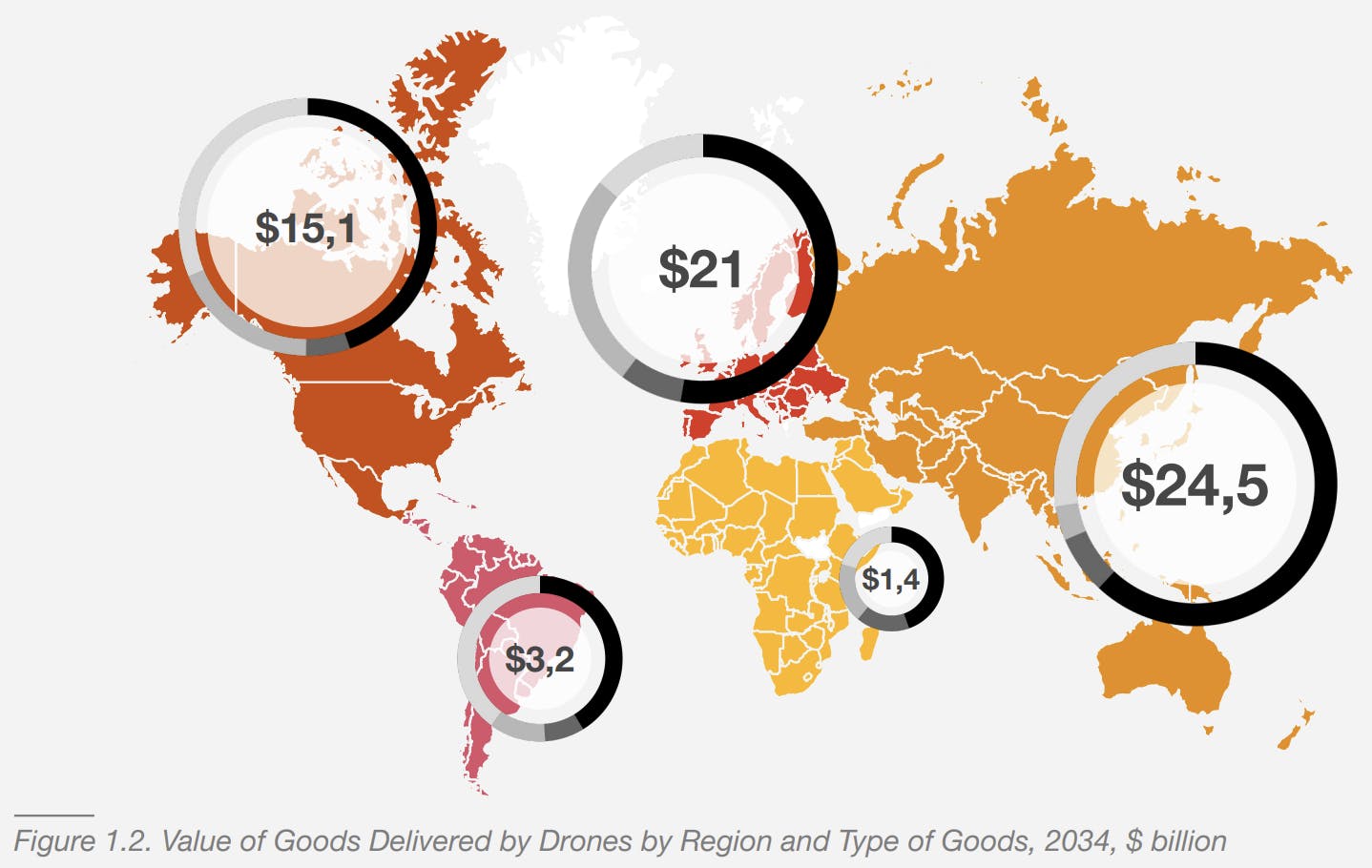
Source: PwC
Based out of California, Zipline operates a global instant logistics and delivery system that is predominantly used to deliver medicines and fulfill commercial deliveries via drones. In 2016, the company began by delivering blood and medical products in Rwanda; it has since grown its delivery services to encompass a broad range of products, including food, agricultural products, animal health products, and retail. Zipline describes itself as being comprised of two delivery platforms, one for “precise home delivery” and another for “long-range delivery”. As of March 2024, the company operates in the US, Rwanda, Ghana, Nigeria, Côte d’Ivoire, Kenya, and Japan, with plans to expand beyond this. As a Zipline representative told Contrary Research in March 2024, the company's mission “is to enable faster, more accessible, cheaper, zero-emission delivery solutions globally.” As of May 2025, Zipline operates the largest autonomous logistics network on Earth.
Founding Story
Zipline was founded in 2014 by Keller Rinaudo Cliffton (CEO), Keenan Wyrobek (CTO), a robotics professional from Stanford, Ryan Oksenhorn, a software engineer, and Will Hetzler (former Head of Business Development), a transportation consultant.
In 2011, Cliffton, a Harvard graduate and former professional rock climber, founded Romotive, a smartphone-controlled robotics company, with Oksenhorn and Hetzler. After participating in Techstars Seattle Class 12, the company raised $115K with a Kickstarter campaign in October 2012. That same month, it raised a $5 million Series A led by Sequoia before going on to raise a further $170K in a second Kickstarter in June 2013. Despite this fundraising success, Cliffton had a change of heart about the direction of the company, stating that:
“The more I thought about it, the harder it was to justify expending my energy on a consumer robotics product that probably wasn’t going to work that well… Robots in the home are a notoriously tough space to crack, and I felt that there were bigger problems I wanted to solve, bigger questions I wanted to answer. There is a joke in robotics that once a robot works and does something well, you don’t call it a robot anymore — you just call it the thing that it does, like a dishwasher. I didn’t see us getting to that place with Romotive.”
As a result, in 2014, Cliffton decided to pivot Romotive into Zipline. The professional relationships among the founders were rooted in past educational and work experiences. Cliffton and Oksenhorn had worked together at Romotive, and Hetzler had been Cliffton's classmate at Harvard. Through a mutual friend, Cliffton was introduced to Wyrobek, who was also keen on working on an impactful project.
Both Cliffton and Wyrobek had family ties to the healthcare industry, with Wyrobek's wife being an epidemiologist and Cliffton's family having been involved in public health. Their shared concern for healthcare logistics was further ignited during travels to Central America and Africa, where they observed inadequate medical supply delivery systems.
In Tanzania, they encountered a database that recorded preventable deaths, a majority of which were due to a lack of access to medical supplies. Motivated by their findings, they aimed to build a healthcare logistics solution. Given Cliffton's robotics expertise and Hetzler's aviation background, the use of drones emerged as a logical method for enhancing the delivery of medical supplies. As Wyrobek put it:
“We were exploring impactful, basic products we wanted to develop, and they were nudging us all the time, saying, ‘We keep hearing about vaccine campaigns and other health initiatives getting stuck on logistics—Go look into that.’”
In 2016, the Rwandan government signed a deal with Zipline to build a distribution center near the Rwandan town of Muhanga, and the company began commercial operations in the country. The company started with delivering blood. As Wyrobek recalled in a May 2023 interview:
“We started with blood, which is that canonical use case for on-demand delivery where it has a shelf life way shorter than you imagined. It’s always scarce no matter what country you’re in, so you want to be able to hold it until you know exactly which blood types are needed in which location, so you don’t waste it. You want to serve as much of the country from a few locations as possible.”
In September 2022, Zipline appointed Deepak Ahuja (ex-CFO of Tesla, Verily) as its Chief Business and Financial Officer.
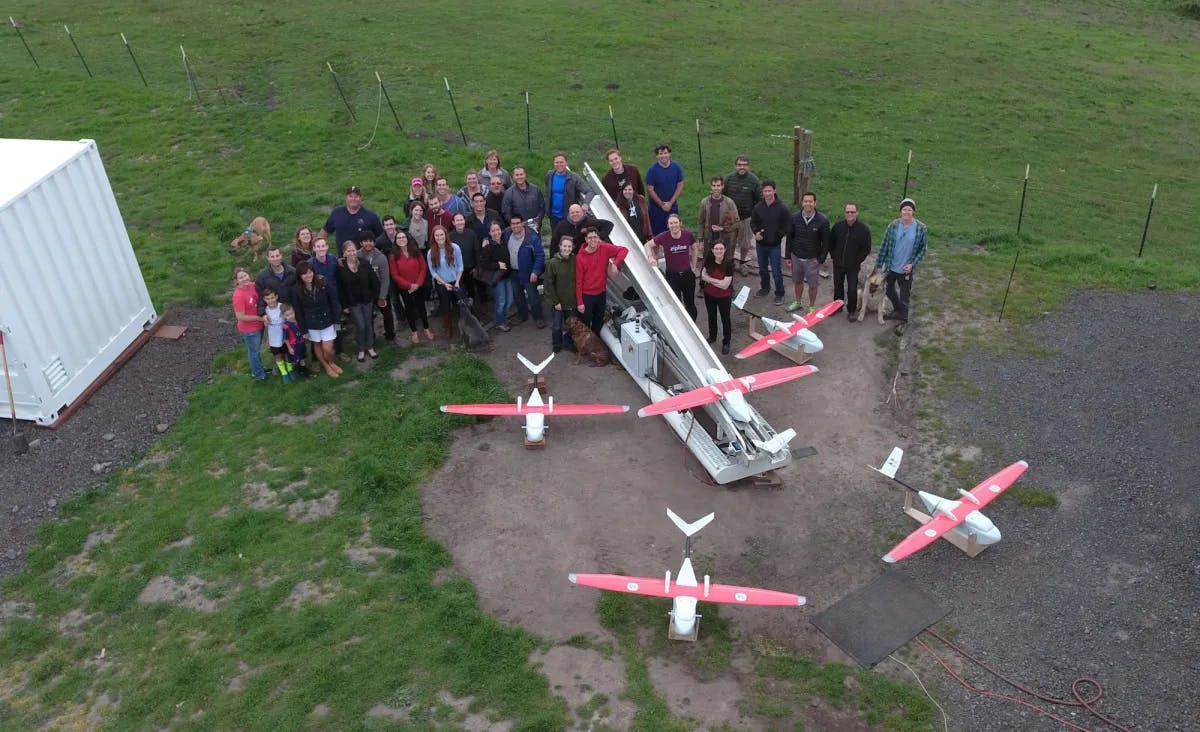
Source: sUAS News
Product
Zipline operates drones known as Zips, which are “autonomous electric delivery drones” that can travel at speeds up to 70 mph. Zipline has two platforms: Platform 1 for long-range delivery and Platform 2 for precise home delivery. Although the company started with blood and medical supply deliveries, as of May 2025, Zipline’s services are used to conduct deliveries spanning healthcare, restaurants, convenience and grocery stories, public health services, agriculture, and more.
At the core of the company’s platforms are its autonomous, electric delivery drones (”Zips”) which are used to conduct deliveries. The company also provides docking services and warehousing services, stating that “we offer end-to-end fulfillment with advanced storage, supply chain management, and instant delivery via our Platform 1 Zips.” Historically, drones have been required to operate with a human operator who maintained line-of-sight with the drone. In September 2023, Zipline was granted a license by the FAA to operate its drones beyond visual line of sight (BVLOS), which alleviated some of those operational limitations.
Platform 1
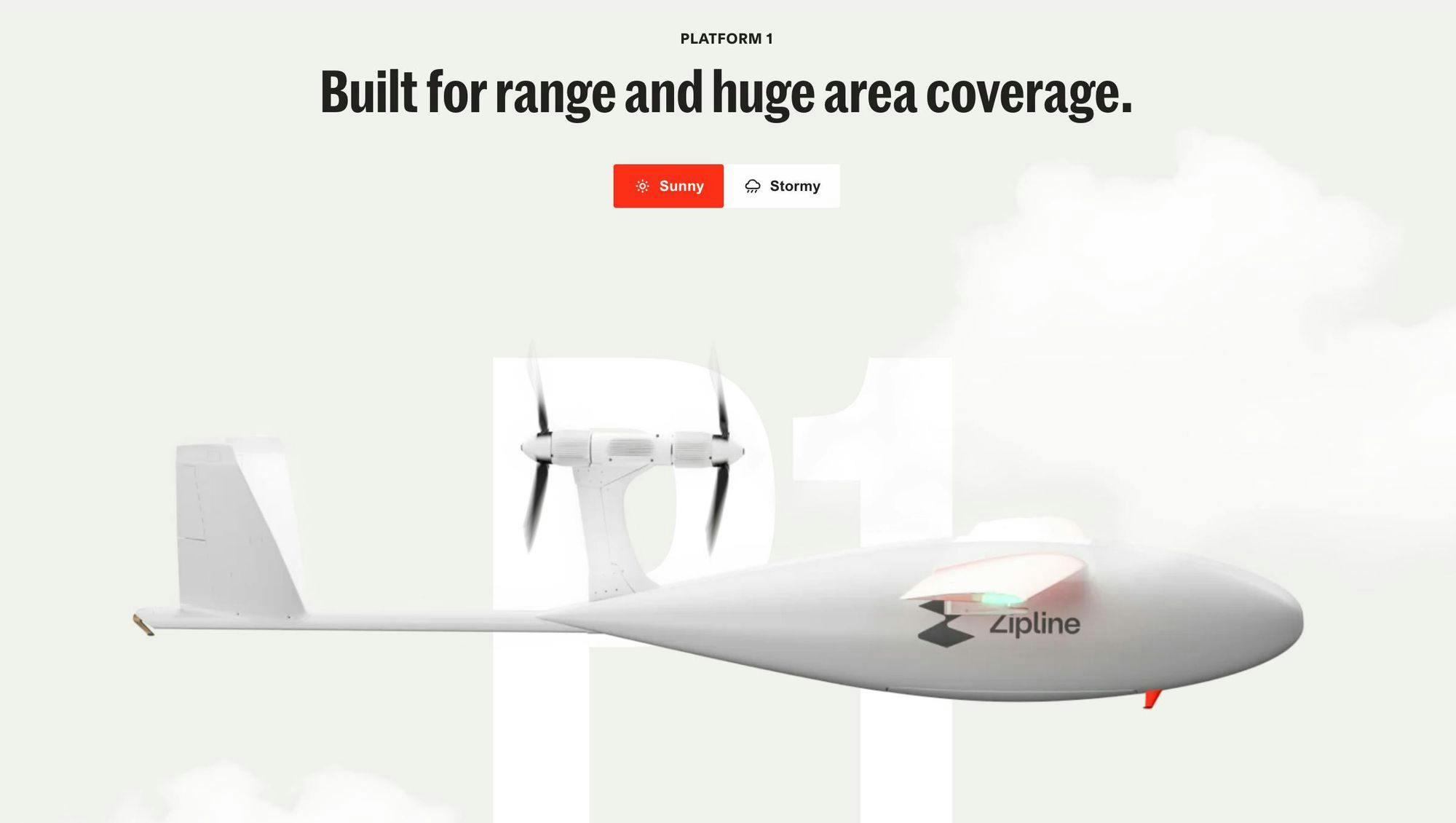
Source: Zipline
Zip’s Platform 1 (P1) has been operational since 2016. The company describes this platform as “built for range and huge area coverage”. As of January 2024, P1 drones have completed over 5 million product deliveries. Products are dropped from P1 “Zips” in mid-air, and the packages land with the help of a parachute. As a whole, the P1 network of drones is intended to offer a comprehensive platform for managing inventory, distribution, and delivery.
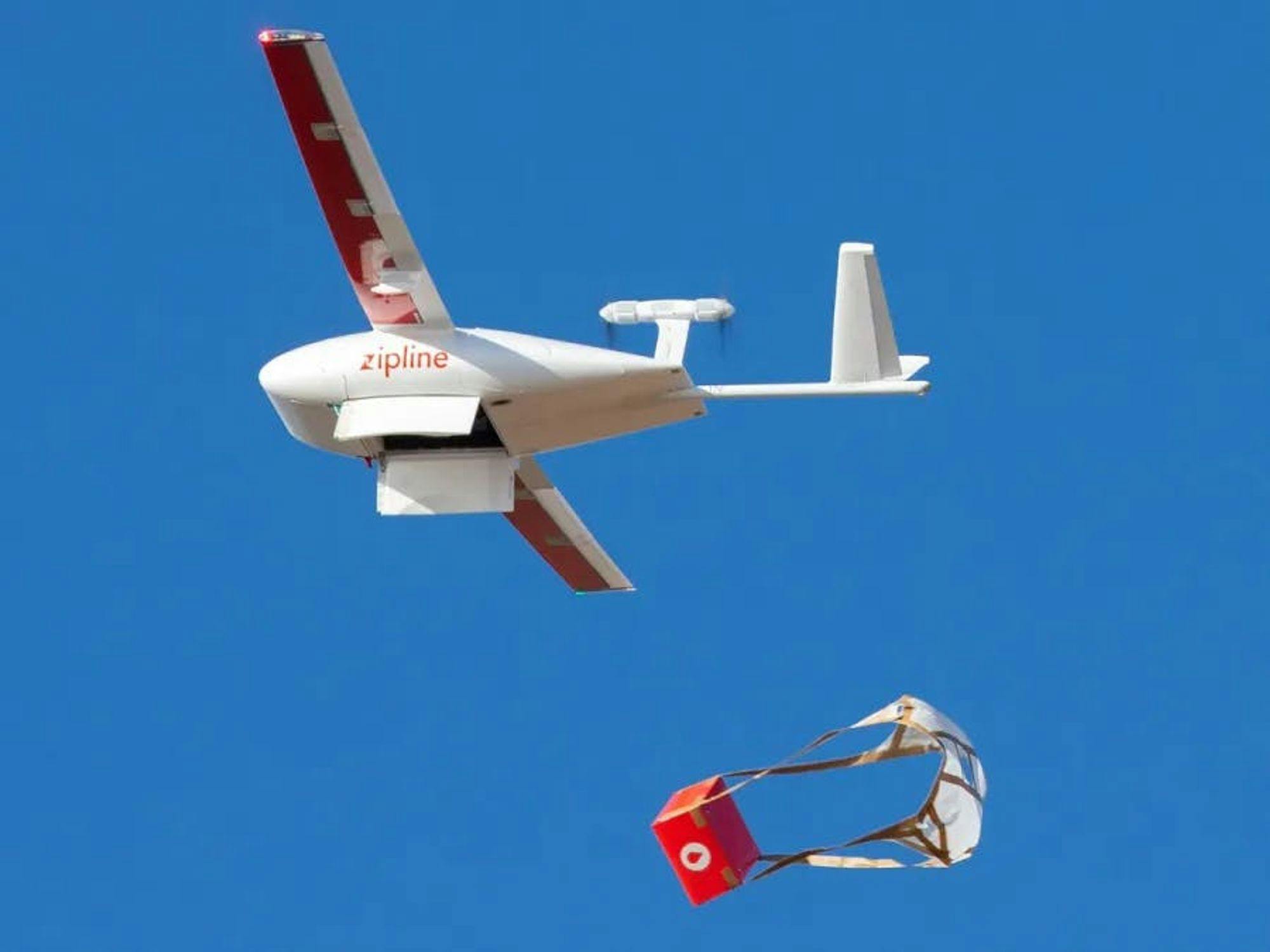
Source: Zipline
The P1 Zip is a fixed-wing drone that travels up to 60 mph with a range of 60 miles. The drone launches via a catapult and comprises “part of a smart launch and recovery system that prioritizes efficiency and area coverage." Zips are designed to minimize noise and disruption, which is aided by the parachute delivery system and the propellers’ acoustic design, which is intended to minimize noise. Zips are also equipped to deliver packages in temperatures ranging from -80ºC to 24ºC.
P1 Zips are launched and recovered at Zip Hubs, which are staffed by human operators and are intended by Zipline to be “smart, scalable operations” that can “distribute hundreds of orders every day at a national scale.”
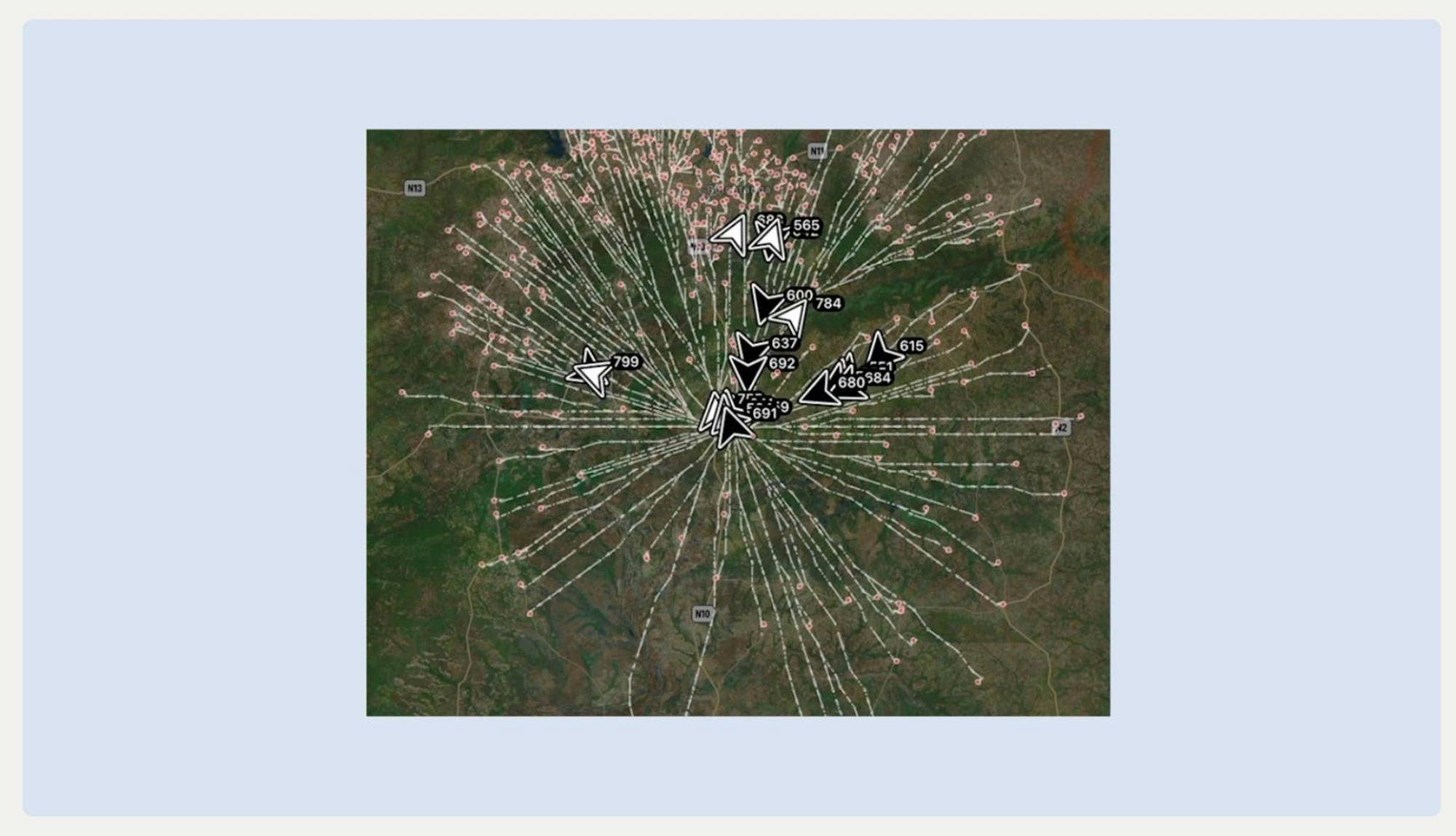
Source: Zipline
Platform 2
Unlike P1, which uses a parachute to deliver packages, Zipline’s Platform 2 (P2) is built for short-distance and precise deliveries. Launched in 2023, this is Zipline’s foray into the commercial delivery and fulfillment business.
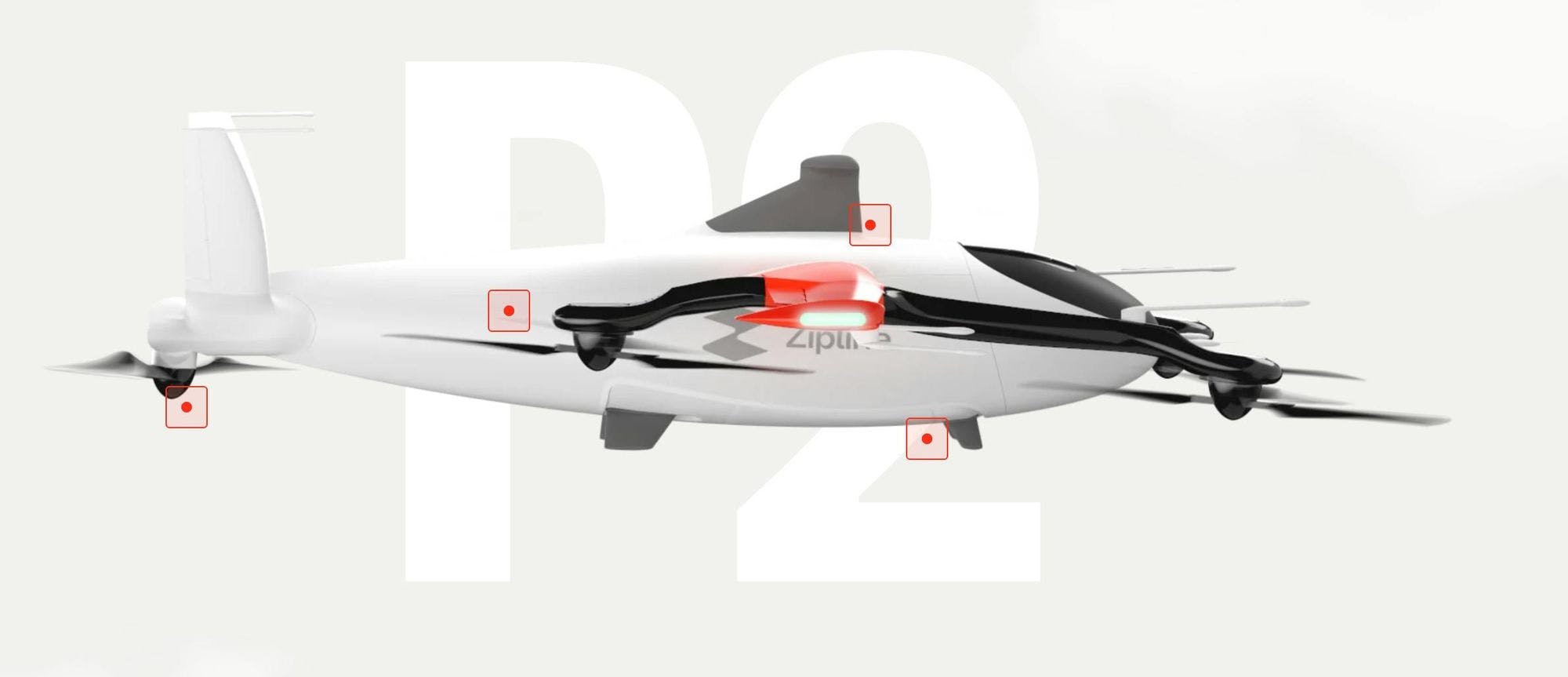
Source: Zipline
P2 Zips are designed differently from P1’s fixed-wing Zips because they serve a different purpose — “seamless integration” into higher-density areas and precise delivery. P2 Zips can travel at up to 60 mph and are able to dock and recharge autonomously at docking stations that look “like a street lamp with an arm and a large disk attached.”These docking stations can be installed in the space of a single parking spot or next to a building, just depending on the local zoning laws and permits, and take “about as much work as installing an electric vehicle charger” according to Zipline CEO Rinaudo Cliffton.
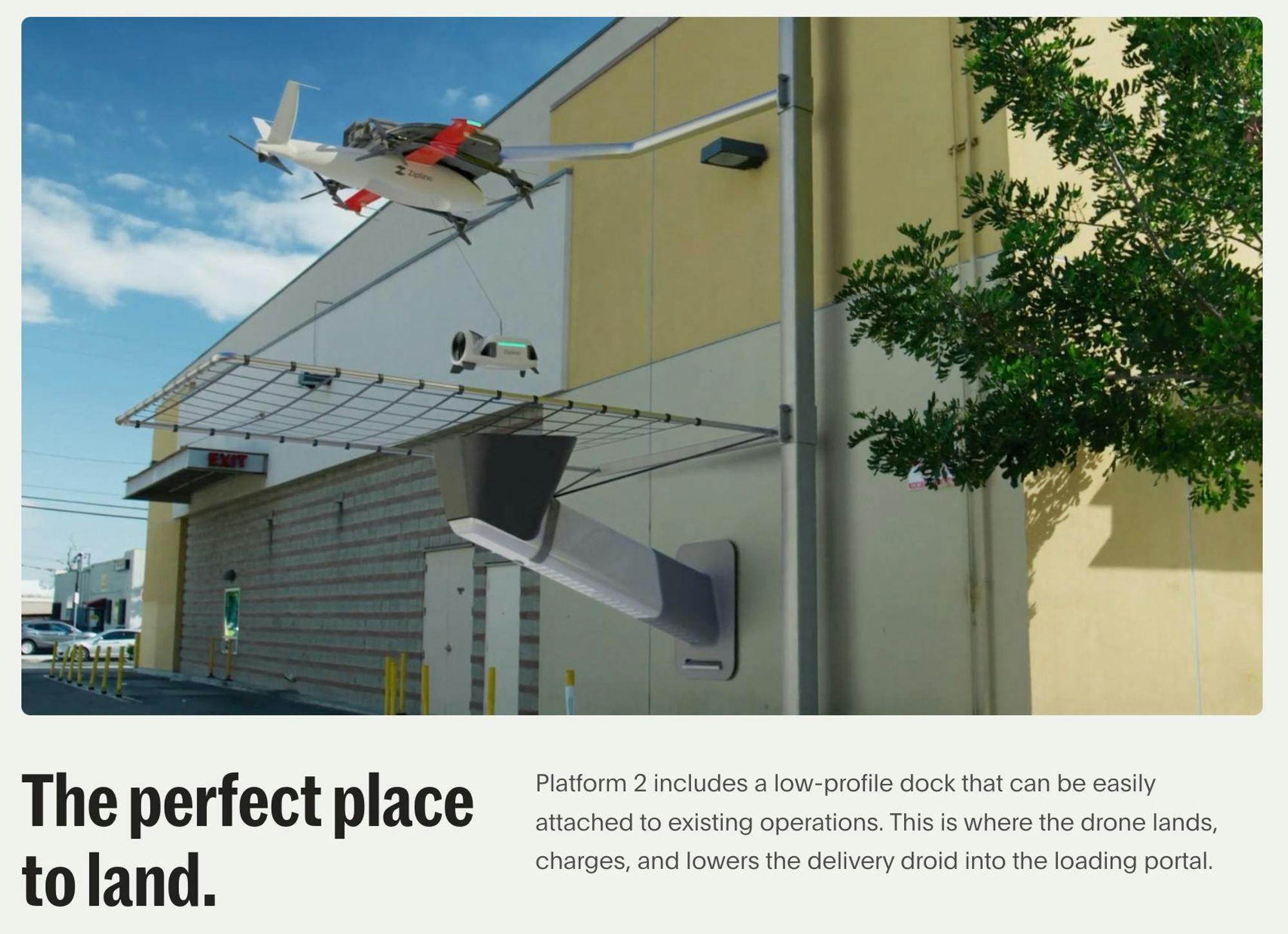
Source: Zipline
P2 Zips have fixed wings, like P1 Zips, but they also have propellers that allow them to hover and help them more precisely maneuver when conducting local deliveries, especially in inclement weather.
P2 Zips are able to deliver packages precisely to a doorstep or any other designated precise location, such as a patio table, with the use of delivery droids that lower from the body of the P2 Zip, which hovers at about 300 feet above ground level, and can use “onboard perception to leave packages exactly where they’re supposed to go.” And as with P1 Zips, P2 Zips are designed to be ‘almost inaudible.”
Software
In addition to its drone platforms, Zipline built a suite of software products that manage ordering, fulfillment, and delivery tracking for customers. Partners access and manage their Zipline services through a centralized dashboard that provides visibility into active orders, inventory, tracking metrics, and performance data.
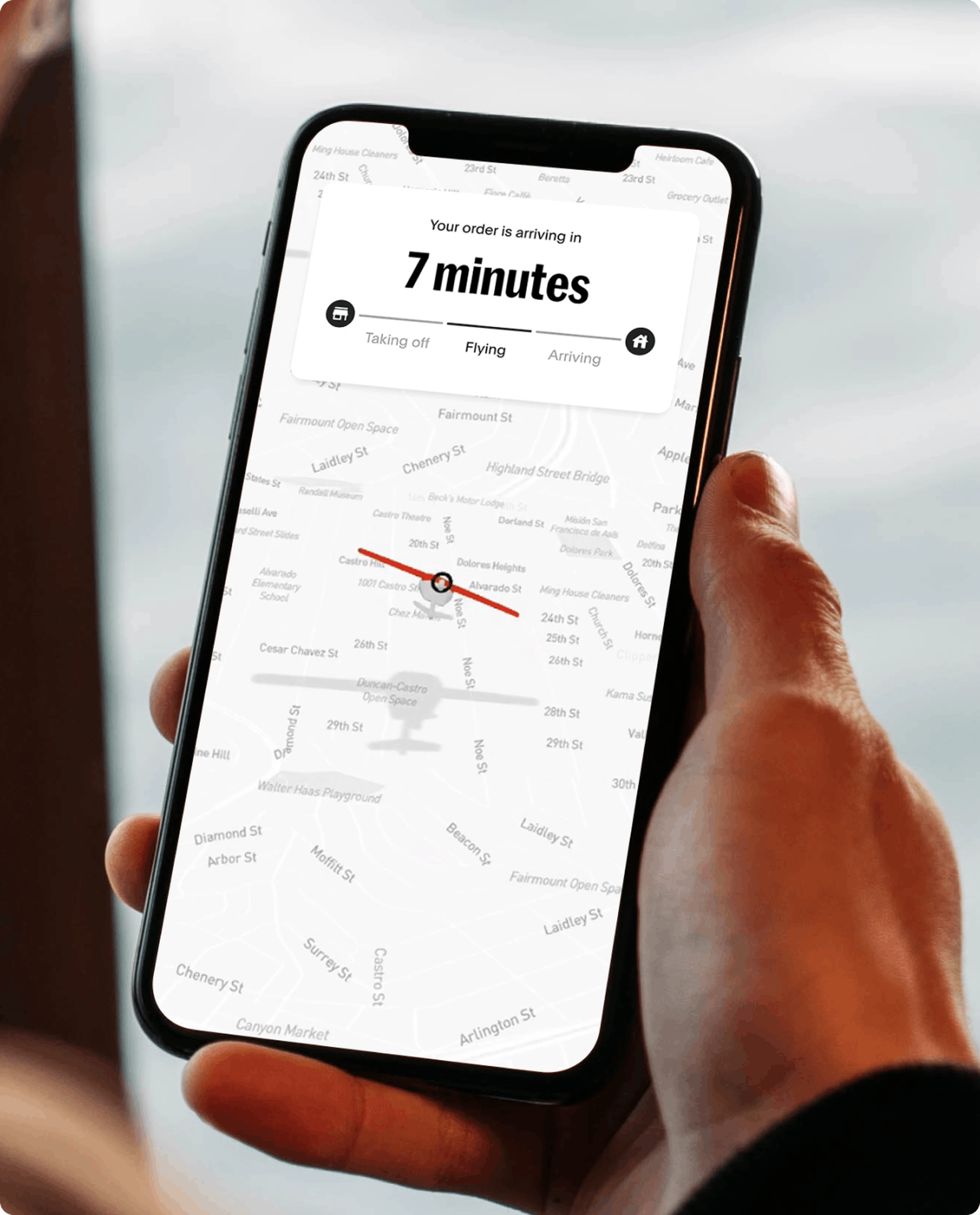
Source: Zipline
Consumers use the Zipline App to place and track orders in real time. As of May 2025, Zipline’s mobile app has over 100 reviews on the Apple App Store and over 1K downloads on Google Play. It is available to users in Pea Ridge, Arkansas, and the Dallas-Fort Worth metropolitan area. The app supports grocery, pharmacy, and restaurant deliveries.
On the operational side, Zipline’s Fulfillment App helps partners oversee shipping, inventory, and customer care, while its fleet management software enables operators to supervise fleet-level operations across entire countries. All Zipline technologies are built at the system level, designed for scalability as partners grow.
Smart Fulfillment

Source: Zipline
Zipline’s platforms are set up so that customers can send inventory directly from suppliers to Zipline’s warehouses for delivery. Zipline says that it can either provide an “end-to-end ordering system” or can integrate directly with customers’ systems. It also takes care of packing and quality assurance before its drone platforms handle delivery, and provides both real-time tracking and analytics for deliveries.
Market
Customer
As of May 2025, Zipline operates across seven countries – the United States, Rwanda, Ghana, Nigeria, Kenya, Côte d’Ivoire, and Japan. By partnering with businesses, non-profits, and governmental organizations, Zipline serves end-consumers and other businesses to fulfill their delivery needs. Zipline’s customers are often based in remote locations, where conventional delivery methods fail to meet demand.
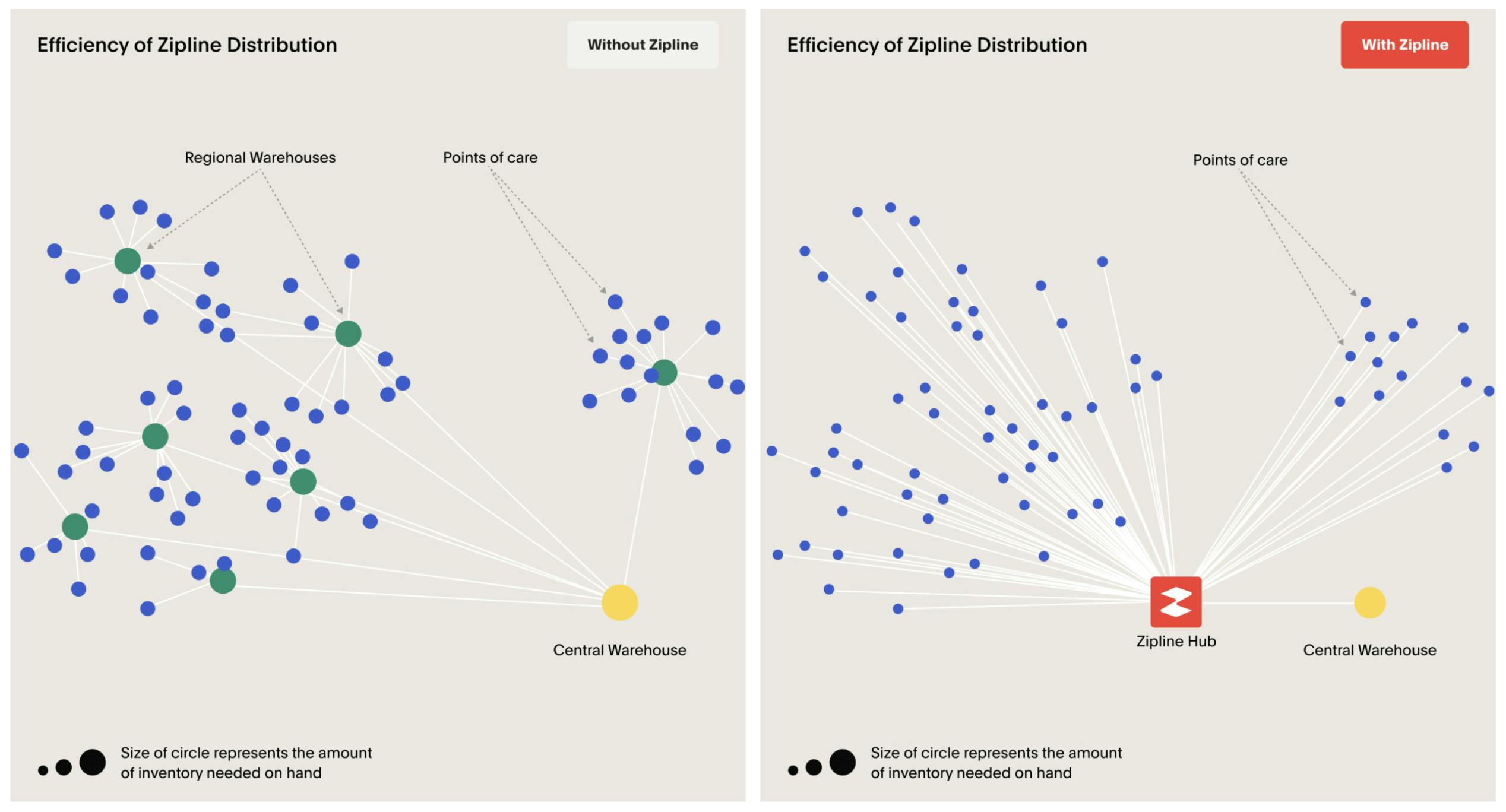
Source: Zipline
Organizations
Zipline serves a broad set of customers across healthcare, public health, grocery, restaurant, and agriculture sectors. Sales cycles can be complex, particularly in healthcare and government, but the value proposition of faster and cheaper logistics has made adoption attractive, especially in rural and hard-to-reach areas where alternatives are limited.
In healthcare, Zipline partners with institutions such as Intermountain Health, Michigan Medicine, Cleveland Clinic, Mayo Clinic, and MultiCare to enable faster home delivery of prescriptions, transport of lab samples, and decentralized patient care. Public health partners include the Health Ministries of Rwanda, Ghana, and Côte d’Ivoire, Pfizer, and the Elton John AIDS Foundation.
In retail and grocery, Zipline works with Walmart, GNC, Panera Bread, Sweetgreen, and Mendocino Farms to fulfill last-mile deliveries directly to customers’ homes, integrating into existing store and restaurant operations. In agriculture, partnerships with organizations like Boehringer Ingelheim, Cowtribe, and the Rwanda Agriculture Board help deliver livestock vaccines and animal health products to rural farmers.

Source: Zipline
Consumers
As of May 2025, Zipline has completed over 15 million deliveries to end consumers worldwide, providing access to healthcare, food, household essentials, and agricultural products. In addition, Zipline operates a direct-to-consumer business in select US regions through its own mobile app. As of May 2025, consumers in Pea Ridge, Arkansas, and the Dallas-Fort Worth metropolitan area can order groceries, pharmacy goods, and restaurant meals through the Zipline App and have them delivered by drone directly to their homes.
Market Size
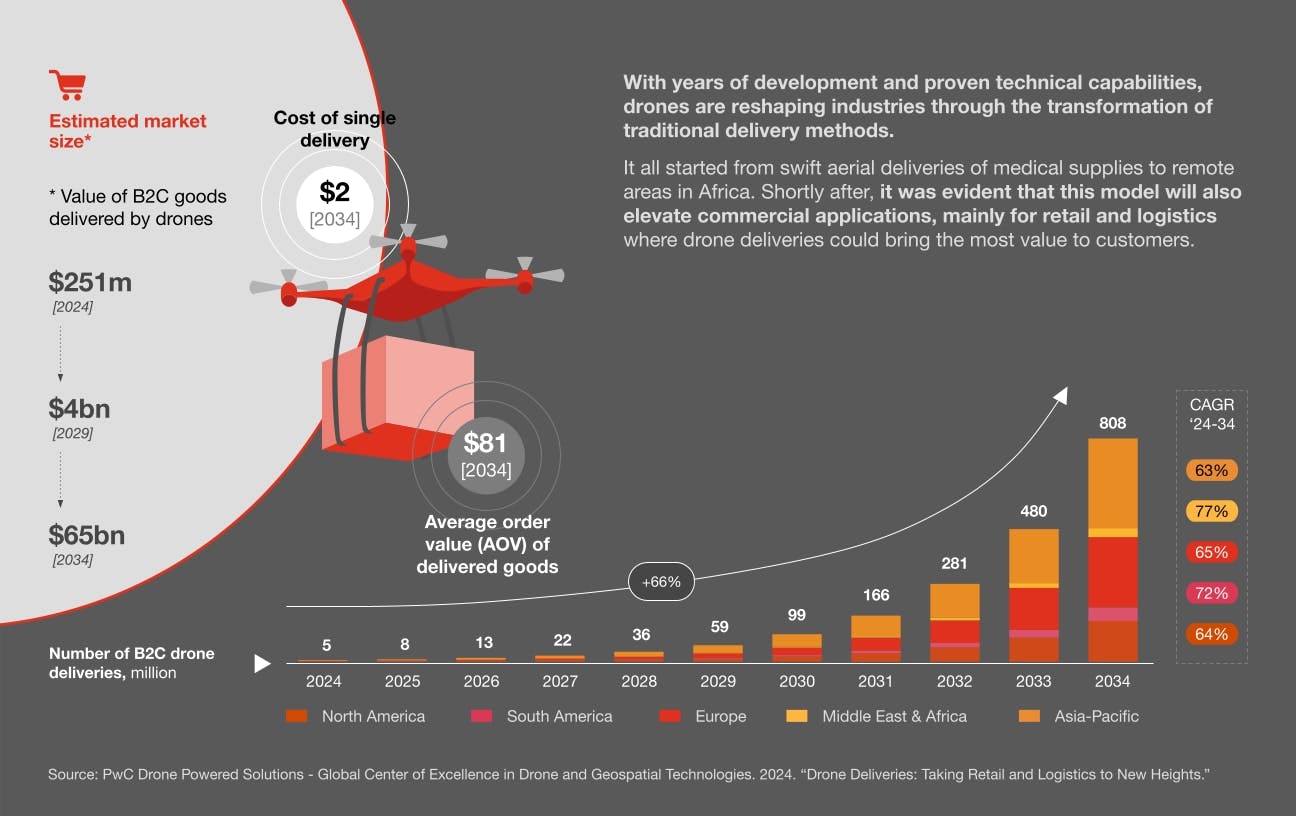
Source: PwC
According to a PwC report, there were over 14K daily B2C drone deliveries globally in 2024. The same year, the total value of goods delivered to customers by drones was over $250 million and projected to surpass $65 billion by 2034. As CEO Keller Rinaudo Cliffton put it, “It’s very obvious that whoever succeeds will be one of the largest companies on Earth — bigger than United Parcel Service and FedEx combined.”
The global market for delivery drones was valued at $873.4 million in 2023 and is expected to grow at a 42.6% CAGR until 2030 to reach a size of $10.5 billion. Growth in this market is being driven by shifting consumer expectations, which place a premium on fast delivery, advancements in drone technology, and the decreasing cost of autonomous delivery systems compared to human labor.
In 2022, retail and ecommerce deliveries accounted for 30% of drone delivery revenue. The global ecommerce market was valued at $16.6 trillion in 2022, making it one of the largest markets on earth — and it is still growing rapidly at an expected CAGR of 27.4%. Ecommerce is expected to reach a market size of $70.9 trillion by 2028. If ecommerce companies increase their adoption of drone delivery even as the market as a whole grows, drone delivery could grow much more quickly than anticipated.
The drone delivery market is limited to operating within visual line of sight per FAA regulation, barring waivers. However, recent regulatory developments suggest a movement towards a more adaptive approach in regulatory policies. For example, a bipartisan bill was introduced in the US Senate in February 2023, aimed at expediting and expanding the FAA approval process for BVLOS drone flights conducted by businesses and public agencies. In August 2023, the FAA issued its first-ever approval for commercial BVLOS operations. Since then, the FAA has issued further exceptions to companies like Flight Forward, uAvionix, PAU, and Zipline in September 2023, Alphabet's Wing in December 2023, and DroneUp in January 2024. These regulatory developments signal a positive shift for the drone delivery market, potentially allowing for broader operational scope and increased adoption of drone-based logistics and services.
Competition
Wing (Alphabet)
Project Wing, a drone delivery company owned by Alphabet, was founded under Google X in 2012 and conducted its first commercial operations in Australia in 2019. The company completed its first real-world deliveries in 2014 in Queensland, Australia. Since then, it has expanded its drone delivery services, achieving milestones like conducting over 1K deliveries per day as of March 2022. As of May 2025, it hit a combined 400K commercial deliveries.
The combined weight of the Wing aircraft, which includes the delivery package, is about 10 kilograms, with the aircraft itself being 8.5 kilograms. Its drones fly at a speed of 70 mph and up to 150 feet above the ground. Wing CEO Adam Woodworth said in March 2023 that:
“Wing’s approach to delivery is different. We see drone delivery at scale looking more like an efficient data network than a traditional transportation system. As with many other areas of technology, from data centers to smartphones, the physical hardware is only as useful as the software and logistics networks that make it meaningful for organizations and their customers.”
Wing’s software oversees three key hardware components: delivery drones, pads for takeoff, landing, and recharging, and autoloaders for loading packages before automatic pickup. Wing obtained a Part 135 certificate in April 2019 and operates delivery programs in 10 locations across three continents. In October 2019, it announced a trial partnership with Walgreens, and in April 2022, Walgreens and Wing launched the first drone delivery operation in a major US metro (Dallas-Fort Worth). It has conducted 350K commercial drone deliveries as of January 2023.
DroneUp
DroneUp is a drone delivery service provider focused on last-mile drone delivery. The company offers solutions for retail businesses, as well as food delivery and medical delivery. Its technology facilitates the integration of drone delivery into existing company operations, intended to enhance the ease and efficiency of implementing autonomous last-mile delivery. For example, its drone “Hubs” allow for rapid deliveries in less than 30 minutes.
Walmart has invested in and has a significant partnership with DroneUp, which operated 34 Hubs for Walmart as of August 2023. In April 2024, DroneUp announced that it would reduce its number of hubs to just 15 locations, as it faced challenges with cost efficiency – each delivery cost an average of $30, making it unfeasible in its current form.
DroneUp’s customer base includes large retailers, hospitals, clinics, and restaurant chains, as well as other types of enterprises and government bodies. For example, its clients include Brookfield Properties, Quest Diagnostics, and NATO Allied Command as of November 2022, as well as Riverside Health System Hospital and Carilion Clinic for medical delivery as of October 2023.
In August 2023, the FAA issued its first-ever approval for commercial BVLOS operations. Since then, DroneUp has also received this exception in January 2024. As of May 2025, DroneUp has raised a total of $14 million.
Amazon Prime Air
Although Jeff Bezos had been planning to utilize drones as early as 2013, Amazon initiated drone deliveries in 2016 with Prime Air. However, it has faced challenges such as workforce turnover and crashes since its initial launch, and a leaked report from Amazon in 2022 stated that Prime Air cost the company $484 per delivery, compared to the less than $5.50 that it cost the company to make ground deliveries through its existing logistics network at the time. Even if the company can reduce that cost to $63 per delivery by 2025, as it reportedly projected, the unit economics still appear unfavorable.
Nevertheless, in August 2020, Prime Air received FAA approval for drone operations. Drones in Prime Air’s delivery fleet are ~5.5 feet in diameter and weigh 80 pounds, designed to carry packages under five pounds in a shoe-box-sized container and travel at 50 mph. In 2022, the company attempted drone deliveries in Lockeford, California, and College Station, Texas, but faced technical issues and experienced unsuccessful outcomes.
As of May 2023, it fell behind their delivery projections, managing only 100 drone deliveries. Amazon also announced the upcoming MK30 model, set to launch in 2024. It will be smaller, quieter by 25% compared to MK27-2, and capable of flying in light rain. The company is said to have invested $2 billion into the development so far. In October 2023, Amazon announced that the MK30 would be delivering to three US locations, along with cities in the UK and Italy, by the end of 2024.
Matternet
Founded in 2011, Matternet develops commercial drone delivery systems for urban and suburban areas. In 2017, it became the first company authorized for commercial Beyond Visual Line of Sight (BVLOS) drone operations over Swiss cities, focusing on medical sample transportation.
Its M2 drone carries payloads of up to 4.4 pounds over distances up to 12.4 miles. In 2019, Matternet partnered with UPS to launch the first regular commercial drone delivery route in the United States. This route efficiently delivered crucial medical supplies to hospitals in North Carolina, showcasing the practical use of drones in healthcare logistics.
Matternet’s M2 Drone delivery system was the first non-military unmanned aircraft to get a Type Certification from the FAA in September 2022 after undergoing a “rigorous evaluation process” where it proved “to be airworthy and eligible for scaled commercial delivery operations”. In November 2022, Matternet obtained an FAA Production Certificate for its M2 Drone. In January 2022, United Parcel Service announced that it had completed 10K flights using the Matternet M2 delivery drone system.
The company was valued at $220 million in May 2022 at the time of its Series B. As of October 2024, Matternet drones had completed "tens of thousands" of commercial flights in the US, Switzerland, Germany, and the United Arab Emirates. As of May 2025, Matternet has raised a total of $74 million.
Manna Drone Delivery
Founded in 2018 by Bobby Healy, Manna Drone Delivery is an Irish company specializing in drone deliveries. Its drones are engineered for high-density suburban last-mile deliveries, capable of carrying payloads of up to 3.5 kilograms (seven pounds). These drones fly at an average flight time of three minutes at altitudes between 50 to 80 meters while reaching speeds exceeding 60 kilometers per hour.
Manna had accomplished over 100K successful delivery flights in Ireland as of October 2023 and secured over $58 million in funding as of May 2025. In March 2023, the company announced a strategic investment by Coca-Cola HBC along with its first US trial in the Dallas-Fort Worth area in partnership with real estate development company Hillwood.
Business Model
Zipline generates revenue through a combination of business logistics services and consumer delivery. Zipline CEO Keller Rinaudo Cliffton described the company’s early business model experiences as follows in 2020:
“When we initially launched in Rwanda, we charged per flight. That wound up being a challenging model for a number of reasons. We were only delivering a few medical products at that time and every additional medical product required a value analysis that took six months. It was slow and invoicing our partners was a pain, so we ended up transitioning the model to an “unlimited” plan where we charged a fixed monthly fee per distribution center that guaranteed unlimited flights—with a daily maximum capacity of hundreds of flights per distribution center.”
The company does not publicly disclose its pricing. In a contract the company signed with Ghana in 2019, the cost per delivery was estimated at $17, which may differ according to geography and depending on which of Zipline’s platforms is being used for the delivery in question.
Zipline manufactures its hardware fully in-house, including drones, docks, and fulfillment portals, and uses Nvidia chips to power flight systems. This vertical integration enables control over costs, reliability, and rapid iteration across its platforms.
In the US, Zipline has expanded into direct-to-consumer operations via the Zipline App, where users in markets like Pea Ridge, Arkansas, and Dallas-Fort Worth can order groceries, pharmacy goods, and restaurant meals for drone delivery. Revenue is generated on a per-transaction basis, similar to other food and convenience delivery platforms. Over time, Zipline’s growing consumer-facing network could enable a shift toward a ‘sharing economy’ model, where goods are delivered and returned instantly rather than individually owned.
Traction
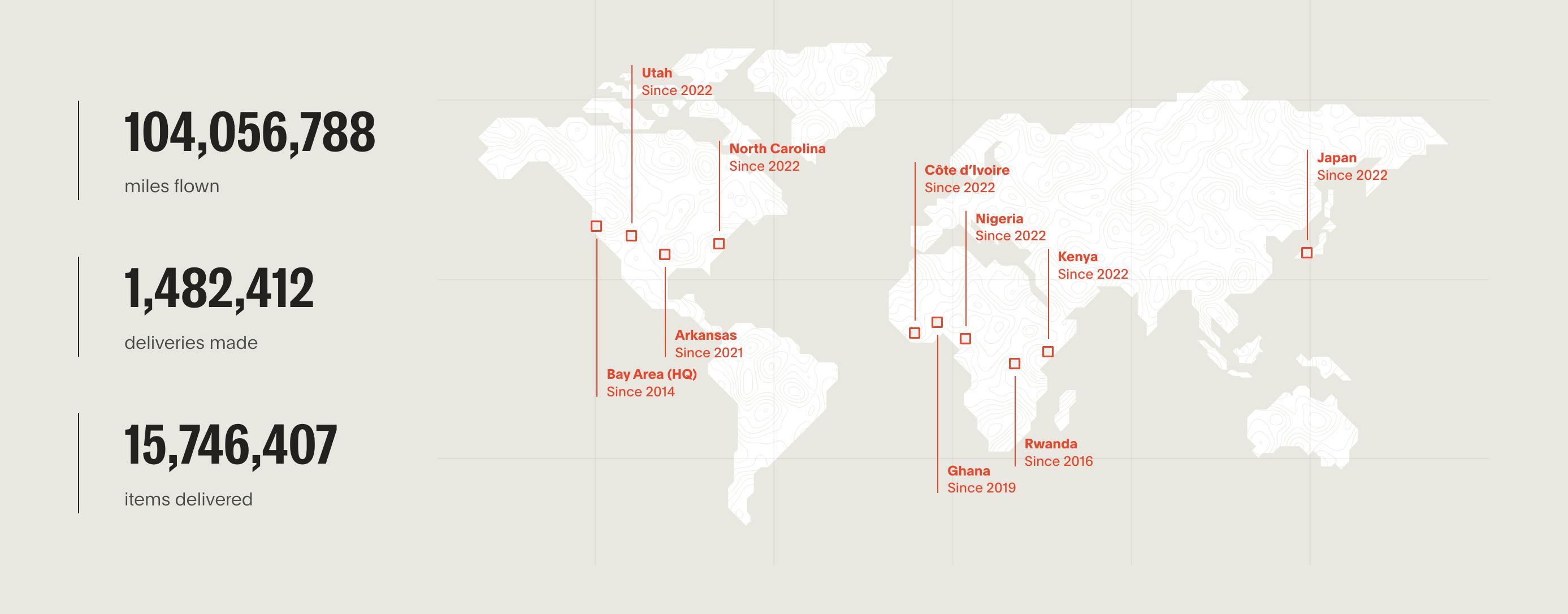
Source: Zipline
As of May 2025, Zipline operates the largest autonomous logistics network on Earth. Its drones have traveled over 100 million miles, delivering more than 1.4 million packages and over 15 million individual items.
The company serves over 4K hospitals and health centers globally and has delivered more than 22 million vaccine doses to date. Research shows a 51% reduction in deaths from postpartum hemorrhaging at hospitals Zipline serves, and 96% of healthcare providers in these regions report improved access to vaccinations.
As of August 2024, Zipline was completing a delivery every 60 seconds across eight countries. By the end of 2025, the company expects to manufacture an average of one Zip drone every hour. Zipline operates in Rwanda, Ghana, the US, Japan, Nigeria, Kenya, and Côte d’Ivoire.
As of February 2024, Zipline serves more than 4K health centers and more than 45 million people. It delivers 75% of Rwanda’s blood supply outside the country’s capital city. According to the company, as of March 2024:
“Zipline completed more deliveries in 2022 than in all previous years combined. By 2025, Zipline expects to operate more flights annually than almost all major U.S. airlines.”
Rwanda
In 2016, Zipline partnered with the Rwandan government to provide automated drone delivery services for healthcare support in remote areas. This was also the world’s first commercial drone delivery service. Initially, it committed to supplying blood to 21 hospitals, which was the focus for the first few years of the company, although it delivered to only one hospital for the first nine months. Since those early days, it has increased its reach to 400 healthcare facilities throughout Rwanda.
Ghana
In 2019, Zipline signed a $12.5 million, four-year contract with the government of Ghana to deliver blood and other medical supplies. This partnership, along with support from GAVI and a few others, aimed to serve a population of 12 million, covering 2K health facilities, making it the world’s largest vaccine drone delivery network.
The United States
In 2020, Zipline entered the United States through a partnership with Novant Health in North Carolina. Together, they established the country's first-ever emergency drone operation. In May 2023, the company announced new delivery deals in the U.S., with nutritional supplement and wellness retail company GNC for Salt Lake City, and Seattle-area pizza chain Pagliacci Pizza for the greater Seattle metro area. In addition, Zipline is a partner for Walmart in its drone delivery operations.
In 2022, Zipline became the first company to receive FAA Part 135 approval for long-range drone delivery in the US. The US Federal Aviation Administration (FAA) authorized Zipline to deliver commercial packages with drones that fly beyond an operator’s line of sight in September 2023.
Valuation
In April 2023, Zipline raised a $330 million Series F at a $4.2 billion valuation, bringing its total funding to $821 million. This represented a substantial increase in valuation from its $250 million Series E, which took place in June 2021 and valued the company at more than $2.7 billion. Notable investors in the company include Sequoia, Andreessen Horowitz, Katalyst Ventures, GV, Pactolus Ventures, Emerging Capital Partners, and Reinvent Capital.
Key Opportunities
Alleviating Pollution & Congestion
The use of traditional delivery vehicles is projected to surge by 36% from 2019 to 2030 in the top 100 global cities. This increase will result in an additional 6 million tonnes of CO2 emissions, posing challenges for cities and automotive companies striving to meet decarbonization goals. Moreover, it will worsen urban congestion, with the average daily commute time potentially rising by 21% due to last-mile delivery alone. This translates to an extra 11 minutes per passenger each day by 2030. Real-world observations in cities like Los Angeles, Chicago, Beijing, and New York City have already witnessed a 20% to 35% increase in commute times since 2010.
Increased drone delivery adoption poses a possible solution to these problems. The delivery landscape places a significant burden on emissions and congestion, primarily due to freight delivery, which constitutes approximately 85% of delivery mileage. Drones can therefore not just be an environmentally friendly alternative but also decongest cities and bring down ever-increasing commute times. According to studies published in 2022, Zipline's aerial deliveries cut down carbon emissions by 97% when compared to traditional gasoline-powered cars, and they also outperform electric vehicles in terms of efficiency.
Commercial Drone Adoption
In a landscape where 85 million packages and documents were being delivered daily worldwide as of January 2023, last-mile delivery stands out as both crucial and cost-intensive, having accounted for half of all logistical expenses in 2023. Projections by the World Economic Forum (WEF) indicate a 78% growth in last-mile delivery by 2030 due to the growth in ecommerce.
Parcel drone delivery revenue has the potential to reach $113 billion by 2030. Traditional delivery, priced at around $4 per parcel, generated approximately $280 billion in revenue as of 2020. Scaling up drone delivery could enable the delivery of food and other packages to consumers in under 30 minutes for less than $1, potentially reducing overall delivery costs by up to ~20 times in the coming decades. An increase in ecommerce sales and consumer preferences for cheap and quick deliveries is likely to further drive the adoption of commercial package deliveries by drones.
Improving Unit Economics
The direct operating cost for single-package drone delivery was approximately $13.50 as of January 2023, which was more expensive than non-drone delivery options. The primary cost driver for drones was labor, accounting for 95%, mainly due to regulations limiting one drone per operator and requiring visual observers in many regions.
For drone delivery to achieve cost competitiveness, technology must advance to enable drone autonomy, sense-and-avoid solutions, and unmanned traffic management systems. Furthermore, regulatory frameworks need to evolve, allowing operators to oversee larger fleets of drones, potentially up to 20 drones in densely populated airspace. With these advancements, single-package drone delivery costs could be reduced to around $1.50 to $2.
Key Risks
Regulatory hurdles
Although companies like Zipline, Wing, and Matternet are headquartered in the US, all of them started their operations outside the country due to complex and slow regulatory processes in the US and the UK. Despite launching in 2013, Amazon’s drones are still nowhere close to full-fledged commercial delivery, and as of September 2023, are operational in only two locations. The delay in regulatory approvals has therefore slowed down the commercial adoption of drones over the past decade. Dr. Catherine Cahill, Director of the Alaska Center for Unmanned Aircraft Systems Integration (ACUASI) at the University of Alaska Fairbanks, stated that:
“The delay in giving us [testing] permissions was a major roadblock in the commercial use of drones and its development. It was a tremendous gap, something we should have had permission for years ago.”
The FAA, responsible for aviation regulation, has been crafting specialized drone regulations for some time. As of January 2024, drones are subject to the same rules as airplanes, despite differences in autonomy, passenger capacity, and risk. Although the FAA offers exemptions and certifications for drone companies to bypass some airline regulations, the process remains cumbersome and limiting for scalability. A major constraint is the "beyond visual line of sight" (BVLOS) rule, which necessitates specific exemptions for drones to operate beyond an operator's visual range. Widespread drone-specific regulation is in development and expected in the coming years, potentially paving the way for drones to become an integral part of daily life.
Privacy & Security Concerns
Safety and privacy concerns present significant risks to the drone industry, impacting public acceptance and regulatory approval, which are crucial for the industry's growth. In terms of safety, the Federal Aviation Administration (FAA) has reported an increase in unmanned aircraft (UAS) sightings from pilots, citizens, and law enforcement over the past two years, with more than 100 such reports each month. This surge in sightings underscores the potential risk of mid-air collisions and the necessity for robust safety regulations and technology to prevent accidents.
On the privacy front, one 2017 survey highlights the public's apprehension about drones flying near their homes, with approximately 54% of Americans reportedly feeling that drones should not be allowed to operate in residential areas. The concern is rooted in the capability of drones to capture detailed imagery and data, which could infringe upon personal privacy. This sentiment is particularly strong among older adults, with 73% believing that drones should not be allowed near people's homes. On the other hand, younger people being more accepting of drones indicates that opinions may shift over time on this issue.
Summary
Zipline, founded in 2014, operates a global instant logistics and delivery system using drones. As of May 2025, Zipline is the world’s largest autonomous logistics network, with over 100 million miles flown by its drones. Initially focused on delivering blood and medical supplies in Rwanda, Zipline now supports healthcare, retail, agriculture, and consumer deliveries across the US, Kenya, Ghana, Nigeria, Côte d’Ivoire, and Japan.
The company offers two delivery platforms: Platform 1 for long-range delivery and Platform 2 for precise home delivery. Both utilize autonomous electric delivery drones known as Zips. Platform 1, operational since 2016, covers large areas, delivering products via mid-air drops with parachutes. Platform 2, introduced in 2023, is designed for short-distance and precise deliveries, with drones capable of docking and recharging autonomously.


